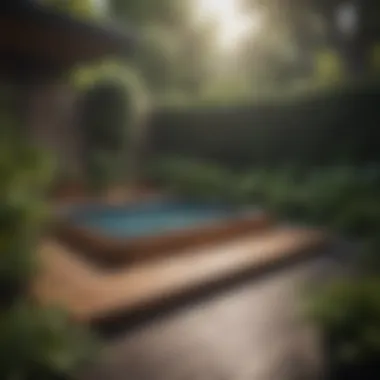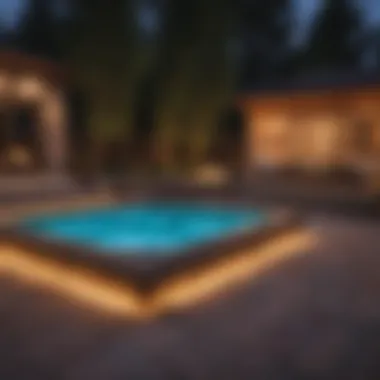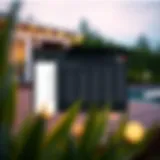Transform Your Outdoor Space with Hot Tub Deck Ideas


Intro
Creating an outdoor space that combines relaxation and style can drastically enhance the value and enjoyment of a home. A hot tub deck serves not only as a stand-alone feature but as an integral part of the overall outdoor aesthetic. As homeowners continue to seek ways to refresh and upgrade their properties, innovative hot tub deck ideas can play a pivotal role. This article aims to unpack unique design concepts, address practical considerations, and highlight the synergy between the hot tub and its surrounding environment.
With the right design, a hot tub deck can transform a simple backyard into a tranquil retreat. It encompasses several facets, including layout, materials, and landscaping, which all contribute to both beauty and functionality. Homeowners, party hosts, and gardening enthusiasts alike will discover elements that resonate with their individual preferences while enhancing the overall outdoor experience.
Let’s explore some design inspirations and essential maintenance tips to make the most of your outdoor space.
Understanding Hot Tub Decks
Creating an inviting outdoor space often begins with a well-designed hot tub deck. Understanding hot tub decks is crucial for anyone looking to enhance their backyard aesthetics while maximizing functionality. A hot tub deck serves as the bridge between relaxation and outdoor living. The right design can elevate not only the appeal of the hot tub but the entire yard. Key elements such as layout, accessibility, and safety play significant roles in how a hot tub deck is perceived and used.
Good design can improve usability and safety. A thoughtfully planned deck considers how the hot tub integrates into the environment, allowing for easy access and fluid movement around it. Accessibility is especially important for families and guests; this includes thinking about things like steps, walkways, and proximity to seating areas. Moreover, a well-constructed deck can protect the hot tub and its components from environmental elements, thus enhancing its lifespan.
In this section, we will examine the importance of deck design and the factors influencing deck construction. Each plays an essential role in maximizing the potential of your outdoor retreat, ensuring that you enjoy both the beauty and functionality of your hot tub area.
The Importance of Deck Design
Deck design is the first step in transforming an outdoor space. It sets the tone for how the area feels and functions. The design must harmonize with the house architecture and landscape. A cohesive aesthetic can create a sense of belonging and tranquility, which is what one seeks in an outdoor sanctuary.
A well-designed deck enhances user experience. It invites relaxation and encourages social gatherings. Features such as built-in seating, lighting, and landscaping further enrich the atmosphere. The goal should be to create a seamless transition between the hot tub and its surrounding spaces.
Additionally, the layout affects how people interact with the hot tub. An open design may promote socialization, while a more secluded layout can offer privacy. Ultimately, the deck design must align with the intended use, ensuring that every detail is tailored to meet the needs of the users.
Factors Influencing Deck Construction
Various factors influence the construction of a hot tub deck, each requiring careful consideration.
- Materials: Selecting the right materials is vital. Choices like wood, composite, or stone each bring unique benefits and challenges.
- Climate: The local climate affects how materials perform. In areas prone to heavy rains, for instance, durable materials that resist moisture should be prioritized.
- Budget: Financial constraints influence choices related to design and materials. A clear budget allows for realistic planning and ensures that your vision remains attainable.
- Size: The size of both the hot tub and the yard impacts the design. Smaller yards may require innovative solutions to maximize space.
- Building Codes: Adherence to local regulations is necessary. Understanding these codes can save time and frustration during construction.
Considering these elements thoughtfully will lead to a superior design. A focused approach will not only enhance the usability of the deck but also contribute to a more satisfying outdoor experience. The interplay of these factors shapes the final outcome, ensuring that your hot tub deck fulfills both its aesthetic appeal and practical function.
Material Selection for Decking
Material selection is crucial when it comes to designing a hot tub deck. The correct choice of materials not only affects the aesthetic appeal of the deck but also its durability, maintenance, and functionality. Different materials provide varied benefits and considerations, influencing the overall experience of using the hot tub. This section will delve into various options available, highlighting their attributes and practical implications.
Wood Decking Options
Cedar
Cedar is a popular choice for hot tub decks due to its natural beauty and resistance to rot and insects. This wood type has a warm color and a pleasant aroma, enhancing the overall atmosphere of the outdoor space. Its lightweight quality allows for easy handling during construction. However, cedar needs regular treatment to maintain its appearance and prevent fading over time. Its unique characteristic of being naturally decay-resistant makes it an ideal option for outdoor environments. While cedar can be more expensive than other wood types, its longevity can justify the higher initial cost.
Redwood
Redwood is another esteemed decking material that offers both beauty and performance. Its rich coloring and fine grain are attractive to many homeowners. Like cedar, redwood has natural resistance to decay and insects. This quality makes it a sustainable option for those concerned about the longevity of their structure. A downside to redwood is that it can be prone to warping, especially in extreme weather conditions. Additionally, its cost can be higher compared to pressure-treated lumber, necessitating consideration of budget in the decision-making process.
Pressure-treated Lumber
Pressure-treated lumber is a cost-effective option for constructing hot tub decks. This material undergoes a treatment process, making it resistant to rot and termites. It is widely available and often more affordable than cedar or redwood, making it a go-to choice for many home improvement projects. However, it may not possess the same aesthetic appeal as natural woods like cedar and redwood. Regular maintenance is essential to prolong its lifespan, and it can require sealants or stains to protect its appearance from the elements. Its durability outweighs its downsides for those seeking a robust decking option.
Composite Materials
Benefits of Composite Decking


Composite decking provides a modern alternative to wood. Made from a mix of recycled wood fibers and plastic, it is designed to withstand harsh outdoor conditions. One key benefit is its low maintenance requirement, eliminating the need for regular staining or sealing. Composite materials are also available in various colors and finishes, allowing for customizable designs. Its resistance to fading and staining is a significant advantage, ensuring the deck looks good for years. However, initial costs may be higher than wood options, which could deter some homeowners from choosing composite.
Sustainability Factors
Sustainability is becoming a pressing concern for many homeowners. Composite materials often use recycled content, making them an eco-friendly choice. They contribute to reducing waste and can have a lower environmental impact compared to traditional wood decking. Composite products typically have a long lifespan, further enhancing their sustainability credentials. On the flip side, the manufacturing process does involve plastics, which might not appeal to environmentally-conscious consumers seeking purely natural materials.
Stone and Pavers
Stone and pavers present a distinctive approach to hot tub decking. They offer durability and a high-end aesthetic appeal. Natural stone is weather-resistant and can withstand various environmental conditions without degrading over time. Pavers, composed of concrete or brick, also provide a sturdy surface. These materials can be visually stunning, with numerous designs and textures available. One key challenge is that both stones and pavers can be more labor-intensive to install and may result in higher upfront costs. Regular maintenance is recommended to keep them clean and looking their best.
Choosing the right material for your hot tub deck necessitates a careful balance between aesthetics, budget, and durability. Each option provides unique advantages and disadvantages that require thoughtful consideration.
Design Layout of Hot Tub Decks
The layout of a hot tub deck plays a crucial role in determining the overall experience and functionality of the outdoor space. By carefully planning the design layout, homeowners can create a harmonious environment that enhances relaxation and encourages social interactions. Several elements contribute to the effectiveness of a hot tub deck layout, including aesthetic appeal, accessibility, and utility.
Focusing on the design layout also enables a strategic arrangement of various features that cater to both the hot tub and the surrounding area, ensuring that they integrate smoothly and functionally.
Choosing the Right Location
Choosing the right location is one of the first critical steps in designing a hot tub deck. The placement should consider sunlight exposure, privacy, and accessibility. A hot tub in a sunlit area may provide warmth during colder months, while a shaded spot keeps the space cool during summer. Privacy is also a major factor; a hot tub deck in a secluded area of the yard can offer a more intimate and tranquil environment for relaxation.
Moreover, accessibility to the house and pathways is essential for convenient usage. Homeowners should ensure that the hot tub is easily reachable from indoor spaces, such as bathrooms or changing rooms, to streamline preparation and clean-up.
Creating Zones Around the Hot Tub
Seating Areas
The design of seating areas around a hot tub creates a welcoming atmosphere, facilitating socializing among guests. When planning seating, it's important to choose comfortable and weather-resistant materials that blend well with the overall aesthetic. Fire pits or outdoor heaters can complement seating areas, making it enjoyable to gather outside even in cooler weather.
A key characteristic of seating areas is versatility. They can accommodate various activities, from casual conversations to lounging with a book. This adaptability often makes them a popular component in hot tub deck designs. However, homeowners should take care with spacing to avoid overcrowding.
Dining Spaces
Incorporating dining spaces adjacent to the hot tub can transform an outdoor area into a multifunctional retreat. This layout encourages outdoor meals, enhancing the experience of enjoying the fresh air and water. A dining area can be set slightly apart from the hot tub, providing a distinct area for meals without sacrificing closeness to relaxation areas.
Dining spaces allow for creative options, such as outdoor grills or built-in tables. Their unique feature is the combination of convenience and enjoyment of outdoor cooking and dining while being close to the hot tub for an after-meal soak. Some downsides may include the requirement of extra cleaning due to food residues, which could complicate maintenance.
Access and Safety Considerations
Access is vital for safety and usability. Wide paths leading to the hot tub allow for easy movement, especially when wet, reducing slip hazards. Handrails and non-slip surfaces are additional safety features that are crucial in avoiding accidents.
Furthermore, it is necessary to consider the distance from other outdoor amenities, such as pools or gardens. Safe access to and from the hot tub contributes to its overall enjoyment and encourages usage. Knowing these factors ensures that the hot tub deck is not only attractive but also a secure environment for all users.
Incorporating Lighting into Your Design
Lighting is a crucial element in designing a hot tub deck. It serves not only to enhance the aesthetic appeal of your outdoor space but also to ensure safety and functionality. Proper lighting can transform your deck into a stunning evening retreat, allowing for comfortable use of the hot tub after sunset. Various lighting techniques can create ambiance, highlight design features, and establish zones within the outdoor area.
When considering lighting, it is essential to evaluate the various types of fixtures available. The placement and intensity of lights can dramatically affect the overall atmosphere. Also, energy efficiency and ease of installation should be taken into account. Thoughtfully installed lights can create a serene environment, catering to relaxation while also providing safety for all users.
Ambient Lighting Techniques
Ambient lighting plays a vital role in shaping the mood around your hot tub. This lighting works to create a warm and inviting atmosphere. There are several ways to achieve effective ambient lighting:
- String Lights: Simple yet effective, string lights can be hung above seating areas or draped around the hot tub. They add a festive feel and can be dimmed for a more tranquil effect.
- Solar Garden Lights: These lights enhance paths and borders around the deck. They require no wiring and offer an eco-friendly option that charges throughout the day.
- Recessed Lighting: Installing recessed lights within the deck itself can provide subtle illumination. This technique is ideal for avoiding glare while achieving a polished look.
- Wall Sconces: If your deck has walls or a surrounding fence, sconces can be installed to cast a soft glow. They work well to highlight architectural features and create a sense of depth.


Utilizing a combination of these ambient lighting techniques can ensure your hot tub area remains functional and appealing at night.
Safety Lighting Solutions
While ambiance is important, safety must also be prioritized in your lighting design. Poorly lit areas can pose risks, particularly around the hot tub. Select safety lighting solutions to enhance navigation and prevent accidents:
- Pathway Lights: These provide illumination along walkways leading to the hot tub. They guide guests safely across the deck, reducing the chances of missteps.
- Step Lights: If your deck has multiple levels, installing step lights can prevent falls. These lights can be placed at the edges of each step, clearly marking each level.
- Motion-Activated Lights: These are ideal for entrances or areas that require security. They light up when they detect movement, offering convenience and additional safety.
- Flood Lights: For larger outdoor spaces, flood lights can illuminate the entire area. While they may be brighter, consider placing them strategically to avoid harsh glares around the hot tub.
Incorporating these safety lighting solutions will not only beautify your deck but also create an inviting and secure environment for everyone to enjoy.
Landscaping Around Your Hot Tub Deck
Landscaping around your hot tub deck plays a vital role in enhancing both the aesthetic appeal and the functionality of your outdoor space. A thoughtfully designed landscape can create a serene and welcoming environment, elevating your relaxation experience. Effective landscaping not only improves the visual charm but also contributes to practical aspects such as privacy and safety.
When thinking about landscaping, consider elements like plant selection, layout, and integration with existing features. The right plants can soften the hard surfaces of the deck and provide a lush backdrop. Moreover, landscaping can help define the space, creating clear boundaries that separate the hot tub area from other outdoor elements.
Selecting Suitable Plants
Choosing the right plants is essential for complementing your hot tub deck. Look for varieties that thrive in your climate and add a touch of elegance to the space. Plants like ornamental grasses can provide movement and texture, while flowering shrubs can add color and fragrance.
Consider low-maintenance options for ease of care. Plants that require minimal water and pruning will help keep the area looking good without demanding excessive effort. Additionally, opt for plants that can tolerate humidity and splashes from the hot tub. Some popular options include:
- Lavender: Offers a calming scent and is drought-resistant.
- Ferns: Add lush greenery and thrive in moist conditions.
- Crosseyed Mary: A hardy perennial that blooms all summer.
Creating a Private Space
Establishing a private and secluded area around your hot tub is important for an enjoyable experience. Here are some methods to achieve this privacy:
Fences
Fences can effectively create a sense of enclosure around your hot tub deck. They serve as a physical barrier, shutting out the view from neighboring properties while enhancing the overall design. A well-chosen fence can contribute greatly to the atmosphere of relaxation. Wood and vinyl fences can suit various styles, from rustic to modern.
One key characteristic of fences is their variability in height and design. This allows for tailored solutions depending on personal preference and local regulations. The solid construction of a fence also adds security by limiting access. However, it’s crucial to consider the potential disadvantages, such as limiting views and light.
Hedging Plants
Hedging plants provide another excellent option for creating privacy. A row of densely planted shrubs can act as a natural privacy screen, softening the edges of your hot tub area. They can also blend seamlessly into the landscape.
One notable feature of hedging plants is their ability to grow taller over time, forming a barrier that enhances seclusion. Popular choices include Boxwood or Privet, known for their dense foliage and adaptability.
However, hedging plants typically require more care than fences. Regular maintenance, such as pruning, is necessary to keep them looking their best. This investment in upkeep is worthwhile, as a lush hedge can contribute significantly to the overall aesthetic.
In summary, thoughtful landscaping around your hot tub deck broadens the appeal of the outdoor space. By selecting the right plants and privacy solutions, you can create a tranquil retreat tailored to your preferences.
Unique Hot Tub Deck Ideas
When considering a hot tub installation, the deck design plays a crucial role in creating an inviting and functional outdoor space. Unique hot tub deck ideas can transform an ordinary area into a stunning retreat, enhancing not only the aesthetic value but also the utility of the space. Innovative designs can offer various benefits such as improved usability, better integration with the landscape, and an enhanced atmosphere for relaxation and entertainment.
Multi-Level Deck Designs
Multi-level deck designs provide an interesting visual aspect by introducing different levels that can serve various purposes. This kind of design is particularly useful for homes built on sloped terrains, where a single-level deck might not be practical. Multi-level platforms allow for distinct zones, such as elevating the hot tub for a better view or creating private seating areas. Visitors can engage with the space through an integrated layout that encourages diverse gathering spots.
Key features of multi-level decks include:
- Variability in Height: Different heights can create a sense of separation between areas.
- Easier Navigation: Stairs can help guide guests through the space smoothly.
- Enhanced Views: Elevated platforms can maximize the beautiful scenery around the deck.


Incorporating a Fire Pit
The integration of a fire pit with a hot tub deck can significantly elevate the experience of outdoor living. Fire pits create a focal point and can extend the functionality of the space into the cooler evenings. The combination of warmth from the fire, together with the soothing qualities of a hot tub, promotes relaxation and social interaction.
When planning to add a fire pit, consider:
- Placement: It should be positioned at a safe distance from the hot tub.
- Safety: Ensure that fire pits follow local regulations and safety practices.
- Materials: Using complementary materials to the hot tub deck will enhance the overall design.
Water Features and Hot Tubs
Incorporating water features, such as fountains or waterfalls, can significantly enhance the ambiance around a hot tub. The sound of flowing water can promote tranquility and create a serene environment. Moreover, these designs can serve a functional purpose, such as providing additional cooling during hot days.
When integrating water features, keep in mind:
- Design Cohesion: The style of water features should harmonize with the existing hot tub and deck materials.
- Maintenance: Regular cleaning and maintenance are necessary to ensure optimal functionality.
- Lighting: Consider installing lights in and around the water feature to create an enchanting atmosphere at night.
Unique hot tub deck ideas do not just beautify the space; they create versatile environments where relaxation and connectivity flourish.
By thoughtfully considering these unique elements, homeowners can design a hot tub deck that is both innovative and inviting, ultimately enhancing their outdoor lifestyle.
Maintaining Your Hot Tub Deck
Maintaining your hot tub deck is essential for both its longevity and appearance. A well-kept deck not only enhances the overall aesthetic of your outdoor space but also ensures safety and functionality. Regular maintenance can prevent costly repairs and keep the area appealing for gatherings and personal use. Neglecting deck upkeep can lead to structural issues, which are often difficult and expensive to address. A simple cleaning routine, along with seasonal tasks, can make a significant difference in preserving your investment.
Regular Cleaning Routines
Establishing a regular cleaning routine is vital in maintaining your hot tub deck. Dust, debris, and residues from the hot tub can accumulate quickly. The frequency of cleaning may depend on your climate and usage, but a good rule of thumb is to perform a basic clean at least once a week.
- Surface Cleaning: Use a soft broom or leaf blower to remove leaves and dirt. A gentle wash with mild soap and water can help in getting rid of stains or grime. Avoid harsh chemicals that can damage the material of your deck.
- Hot Tub Area: Ensure that the area around the hot tub is free from algae or mold. These can develop easily due to moisture. Inspect and clean under any furnishings where debris may collect.
- Furniture and Accessories: Regularly check furniture for signs of wear. Wipe them down to prevent dust buildup and prolong their life.
By maintaining this cleaning routine, you create an inviting environment and ensure that your hot tub is placed in a clean, safe area.
Seasonal Maintenance Tasks
Seasonal maintenance is also crucial for the long-term care of your hot tub deck. Different seasons pose unique challenges that require a tailored approach.
- Spring Clean-Up: After winter, perform a thorough check of the deck. Look for damage from ice or snow, and repair any loose boards. Reapply sealant if your deck is made of wood, as moisture can lead to decay if not properly sealed.
- Summer Preparations: During the summer, ensure that the deck can handle increased sun exposure. Consider reapplying UV protectant to prevent fading. Keep an eye on the hot tub water levels, as usage can lead to faster evaporation.
- Autumn Readiness: As leaves begin to fall, it is important to clean the deck regularly to prevent staining and clogged drains. Cover furniture and the hot tub itself to protect from harsh weather.
- Winter Protections: Address any wear from the previous seasons. If you live in colder areas, consider insulating your hot tub and deck to prevent freezing.
Each season has its own demands, and addressing these through specific maintenance tasks ensures your deck remains functional and safe, creating a pleasant experience for all who use it.
Maintaining your hot tub deck is not just about aesthetics; it’s about ensuring safety and longevity in your investment.
By adhering to these maintenance practices, you can prolong the life of your hot tub deck. With proper care, you will enjoy a beautiful space that enhances your outdoor environment for years to come.
Final Thoughts on Hot Tub Deck Design
Designing a hot tub deck involves a careful blend of aesthetic appeal and practical functionality. As this article illustrates, your outdoor space is an extension of your living environment. Therefore, the design of your hot tub deck carries both aesthetic and recreational significance.
Balancing Aesthetics and Functionality
In any design project, especially in outdoor spaces, striking a balance between aesthetics and functionality is paramount. A hot tub deck should not only look good but also provide a safe and accessible area for relaxation. Choosing materials that align with the natural beauty of the surrounding landscape can enhance the overall appeal. For example, natural wood or composite materials provide durability while maintaining a warm look.
Consider integrating landscaping elements, such as native plants or decorative rocks, which can enhance visual interest without compromising usability. This approach caters to both beauty and practicality. The layout must also prioritize ease of movement, ensuring that spaces do not feel cramped, even during social gatherings.
Investment in Outdoor Lifestyle
Creating a hot tub deck can be seen as an investment in lifestyle rather than just a home improvement. By enhancing your outdoor area, you create an inviting environment for entertaining or unwinding after a long day.
Hot tub decks often provide a point for gathering, socializing, or simply enjoying nature. Consider your personal preferences and how you use your outdoor space. Adding features like seating areas, privacy screens, or even a small bar can significantly elevate the user experience.
Ultimately, a well-designed hot tub deck should enhance the enjoyment of your home. As trends continue to evolve, focusing on both the aesthetic and functional aspects of design will allow homeowners to create spaces that foster relaxation and connection to the outdoors.







